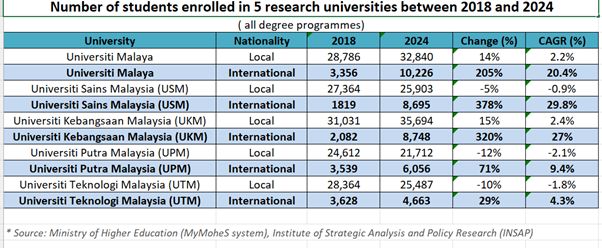
The number of international students studying in top five public universities in Malaysia has outnumbered local Chinese students, says Kedah education exco Professor Dr. Haim Hilman Abdullah
A former vice chancellor of Universiti Utara Malaysia, Dr Haim is one of those voicing his concerns about the direct enrollment of international students in public universities.
Among the five top research universities in Malaysia—Universiti Malaya (UM), Universiti Sains Malaysia (USM), Universiti Kebangsaan Malaysia (UKM), Universiti Teknologi Malaysia (UTM), and Universiti Putra Malaysia (UPM)—international students account for 21.3 percent of the student population, while local Chinese students only make up 13 percent to 13.5 percent.
He cited the 2024 Ministry of Higher Education (MOHE) data showing that there are as many as 30,714 international students from China in the public universities in Malaysia, followed by Indonesia (4,145), Iraq (2,098), and only 91 from the United States.
“The globalization has not attracted students from Western countries but squeezing resources meant for local students,’’ he said.
Citing data from MOHE in 2024, Dr Haim stated that the total number of students in these five public universities is 180,024, of which 38,388 are international students.
According to data from MOHE’s MyMoheS system, which lists 20 public universities, the total student population in 2024 was 611,798, with international students making up 53,322, or 8.72 percent, he said.
“However, as many as 21.3 percent of international students are concentrated in the top five universities, which is much higher than the national average of 8.72 percent,” he said.
“I can accept 5 percent, as it helps with cross-cultural exchange. But when the ratio is as high as 21 percent, even surpassing the percentage of Malaysian Chinese students, it is extremely unfair to local students.
“We must prioritize our people. I am not looking at this issue from the perspective of Malays alone, but from the perspective of all Malaysians. The current situation is very unclear,” he said.

Dr Haim questioned why Malaysian Chinese students only account for 13 percent of the university enrollment, given that the country’s population consists of 70 percent Malays, 20 percent Chinese, 7 percent Indians, and 3 percent others.
“These opportunities to study belong to Malaysians, not foreigners! These places are provided by the government and funded by taxpayers, so they should belong to Malaysians!” he said.
He emphasized that the five top public universities in Malaysia are key institutions supported by the government, receiving substantial funding.
Lecturers from these universities are sent to top global institutions like Harvard University, Yale University, and Cambridge University for further training.
Upon their return, they should be nurturing a new generation of outstanding Malaysians, but the ultimate beneficiaries are a large number of international students.
He called on the government to take a long-term view and re-evaluate the student enrollment system to ensure that opportunities to study are prioritized for Malaysians, “regardless of whether they are Malay, Chinese, Indian, or indigenous people from Sabah and Sarawak.”
Dr Haim refuted the claim that international students help improve university rankings, stating that public universities have lost their direction and questioned whether their mission should be educating citizens rather than going after rankings.
He further pointed out that outside of the top five universities—UM, UKM, USM, UTM, and UPM—the percentage of international students in the remaining 15 public universities is only 5 percent or less, which shows that international students are only concentrated in high-ranking institutions.
Dr Haim warned that international students are eligible to apply for a “graduate pass” to stay and work in Malaysia, which could be a double blow to local graduates: competing for both university places and job opportunities.
He revealed that last year, more than 30,000 Chinese students were studying in Malaysia, and if all of them were to graduate and stay, the job market would face immense pressure.
In addition, Nobel laureate Muhammad Yunus from Bangladesh has formally proposed that graduates from his country be allowed to work in Malaysia, a proposal the government is now studying, which further aggravates the concern.
He stressed his commitment to the “Malaysian First” principle, believing that education is key to poverty eradication, and urged the government to take three major measures:
Strictly control the ratio of international students to below 5 percent in every university.
Secondly, disclose transparent data in public and establish a royal commission to investigate enrollment.
Thirdly, establish a higher education system by focusing on nurturing local talent.
ADVERTISEMENT
ADVERTISEMENT


































